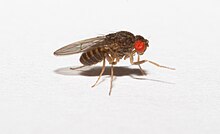| Drosophila hydei | |
|---|---|

| |
| Drosophila hydei | |
| Scientific classification | |
| Kingdom: | Animalia |
| Phylum: | Arthropoda |
| Class: | Insecta |
| Order: | Diptera |
| Family: | Drosophilidae |
| Genus: | Drosophila |
| Subgenus: | Drosophila |
| Species: | Drosophila hydei |
| Binomial name | |
| Drosophila hydei Sturtevant, 1921 | |
Drosophila hydei (mosca casera) is a species of Diptera, or the order of flies, in the family Drosophilidae. It is a species in the hydei species subgroup, a group in the repleta species group. Bizarrely, it is also known for having approximately 23 mm long sperm, 10 times the length of the male's body. Drosophila hydei are commonly found on compost piles worldwide, and can be rudimentarily identified by eye owing to their large size and variegated pigment pattern on the thorax. The name derives from Dr R. R. Hyde, who first discovered that the species was distinct from Drosophila repleta. D. hydei are one of the more popular flies used as feeders in the pet trade. A few varieties are available, some flightless. They are very similar to Drosophila melanogaster, despite having separated 50 million years ago.
Wild populations of D. hydei can be infected with Spiroplasma bacteria that defend the fly against parasitoid wasps.
Contribution to invertebrate genetics
The Class II "Minos" transposon was identified as a repetitive element in the genome of Drosophila hydei. Minos transgenic tools derived from the element in Drosophila hydei have been used in an extremely wide variety of invertebrate and arthropod genomes to disrupt genes for study. Minos is a member of the Tc1/mariner family of DNA transposons. In the genetic workhorse Drosophila melanogaster, Minos transgenesis has been used to disrupt over 10,000 genes as part of the "Drosophila Gene Disruption Project," allowing the study of their function.
Sperm
Large sperm is a noted phenomenon among Drosophila species, but Drosophila hydei have the largest recorded sperm at over 20 mm long. This seems to be linked to female flies mating more often. There is a trend that as sperm metabolic rate increases, female mating frequency and sperm length increase. The DNA required to make this sperm has large introns, genetic material that is removed before the rest is translated into proteins. The genes blanks and heph show strong likelihood of being the regulators of this process.
References
- Greg S. Spicer; Scott Pitnick (1996). "Molecular Systematics of the Drosophila hydei Subgroup as Inferred from Mitochondrial DNA Sequences". J Mol Evol. 43 (3): 281–286. Bibcode:1996JMolE..43..281S. doi:10.1007/BF02338836. PMID 8703094. S2CID 33082794. PDF Archived June 11, 2010, at the Wayback Machine
- Pitnick, S.; Markow, T.A. (1994). "Large-male advantages associated with costs of sperm production in Drosophila hydei, a species with giant sperm". Proc. Natl. Acad. Sci. USA. 91 (20): 9277–9281. Bibcode:1994PNAS...91.9277P. doi:10.1073/pnas.91.20.9277. PMC 44795. PMID 7937755.
- Sturtevant, A. H. (1921). The North American Species of Drosophila. Washington, DC: Carnegie Institute of Washington. p. 101.
- Zhao, Li; Begun, David J. (October 2, 2017). "Genomics of parallel adaptation at two timescales in Drosophila". PLOS Genetics. 13 (10): e1007016. doi:10.1371/journal.pgen.1007016. ISSN 1553-7404. PMC 5638604. PMID 28968391.
- Xie, Jialei; Vilchez, Igor; Mateos, Mariana (2010). "Spiroplasma Bacteria Enhance Survival of Drosophila hydei Attacked by the Parasitic Wasp Leptopilina heterotoma". PLOS ONE. 5 (8): e12149. Bibcode:2010PLoSO...512149X. doi:10.1371/journal.pone.0012149. PMC 2921349. PMID 20730104.
- Pavlopoulos, Anastasios; Oehler, Stefan; Kapetanaki, Maria G.; Savakis, Charalambos (2007). "The DNA transposon Minos as a tool for transgenesis and functional genomic analysis in vertebrates and invertebrates". Genome Biology. 8 (Suppl 1): S2. doi:10.1186/gb-2007-8-s1-s2. ISSN 1474-760X. PMC 2106841. PMID 18047694.
- Metaxakis, Athanasios; Oehler, Stefan; Klinakis, Apostolos; Savakis, Charalambos (2005). "Minos as a genetic and genomic tool in Drosophila melanogaster". Genetics. 171 (2): 571–581. doi:10.1534/genetics.105.041848. ISSN 0016-6731. PMC 1456772. PMID 15972463.
- Bellen, Hugo J.; Levis, Robert W.; He, Yuchun; Carlson, Joseph W.; Evans-Holm, Martha; Bae, Eunkyung; Kim, Jaeseob; Metaxakis, Athanasios; Savakis, Charalambos; Schulze, Karen L.; Hoskins, Roger A. (2011). "The Drosophila gene disruption project: progress using transposons with distinctive site specificities". Genetics. 188 (3): 731–743. doi:10.1534/genetics.111.126995. ISSN 1943-2631. PMC 3176542. PMID 21515576.
- ^ Turnell, Biz R.; Reinhardt, Klaus (March 2022). "Sperm metabolic rate predicts female mating frequency across Drosophila species". Evolution. 76 (3): 573–584. doi:10.1111/evo.14435. ISSN 0014-3820. PMID 35064568. S2CID 246219228.
- Pitnick, S; Markow, T A (September 27, 1994). "Large-male advantages associated with costs of sperm production in Drosophila hydei, a species with giant sperm". Proceedings of the National Academy of Sciences. 91 (20): 9277–9281. doi:10.1073/pnas.91.20.9277. ISSN 0027-8424. PMC 44795. PMID 7937755.
- Bateman, Jack R.; Anderson, David J. (May 9, 2019). "Taming the giant within". PLOS Genetics. 15 (5): e1008098. doi:10.1371/journal.pgen.1008098. ISSN 1553-7404. PMC 6508613. PMID 31071083.
Further reading
- H. D. Berendes (1965). "Salivary gland function and chromosomal puffing patterns in Drosophila hydei". Chromosoma. 17 (1): 35–77. doi:10.1007/BF00285155. PMID 5833949. S2CID 40685620.
- H. D. Berendes; H. G. Keyl (1967). "Distribution of DNA in Heterochromatin and Euchromatin of Polytene Nuclei of Drosophila hydei". Genetics. 57 (1): 1–13. doi:10.1093/genetics/57.1.1. PMC 1211656. PMID 6077528. PDF
- J. B. Boyd; H. D. Berendes; H. Boyd (1968). "Mass Preparation of Nuclei from the Larval Salivary Glands of Drosophila hydei". Journal of Cell Biology. 38 (2): 369–376. CiteSeerX 10.1.1.281.8496. doi:10.1083/jcb.38.2.369. PMC 2107489. PMID 5664209. PDF